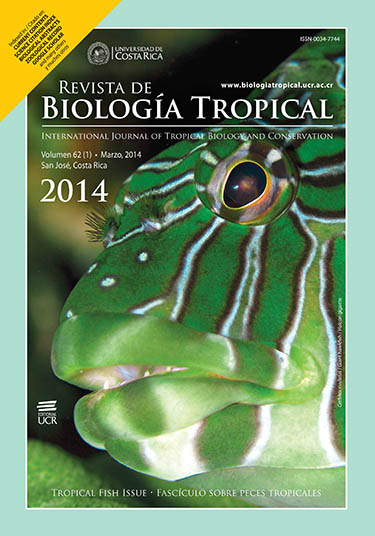Resumen
Los fragmentos rocosos comprenden un hábitat importante para el mantenimiento de la biodiversidad en las regiones costeras, particularmente cuando estos se encuentran en áreas protegidas dominadas por sedimentos blandos. A pesar de que los fragmentos rocosos proporcionan refugio, zonas de crianza y fuentes de alimento para una gran variedad de especies bentónicas, las investigaciones sobre este hábitat en la costa de la Amazonia han recibido poca atención. El presente estudio describe la composición de macroinvertebrados vágiles y la riqueza de especies en los fragmentos rocosos del intermareal de la isla Areuá en la Reserva Marina Extractiva (RESEX) "Mãe Grande de Curuçá", en la costa brasileña de la Amazonia. Las muestras fueron recolectadas durante la estación seca (agosto y noviembre 2009) y de lluvias (marzo y mayo 2010) en dos zonas del intermareal (superior e inferior), con un cuadrante de 625cm². En cada zona del intermareal y por temporada se tomaron muestras de macroinvertebrados a lo largo de cuatro transectos (20m cada uno) dispuestos paralelamente a la línea de costa. Dos cuadrantes se muestrearon al azar dentro de cada transecto. Los macroinvertebrados recolectados fueron identificados y se determinó la densidad y la biomasa de organismos para caracterizar la diversidad bentónica de los fragmentos rocosos. La riqueza de especies de las dos zonas del intermareal durante las estaciones seca y de lluvias se estimó por el método de Jackknife. La comunidad de macroinvertebrados estuvo compuesta por 85 taxones, con 17 taxones "único", 40 taxones fueron comunes para ambas zonas del intermareal y temporadas, y 25 taxones se reportaron por primera vez para la costa brasileña de la Amazonia. La riqueza de especies se estimó en 106±9.7 taxones, por lo que los resultados sugieren que el esfuerzo de muestreo fue representativo. La Clase Polychaeta dominó en número de especies, seguida por Malacostraca y Gasteropoda. Los crustaceos Dynamenella tropica, Parhyale sp. y Petrolisthes armatus fueron las más frecuentes, con una frecuencia de presencia >75% mientras que 39 taxones fueron los menos comunes, con una frecuencia de presencia <5%. La presencia de crustáceos y poliquetos fue particularmente notable en las dos zonas y temporadas, incluyeron 15 y 13 taxones, respectivamente. La Clase Malacostraca fue la más conspicua en términos de abundancia y biomasa, representó más de la mitad de todos los individuos recolectados, con dominio de Petrolisthes armatus. Esta especie fue una de las más numerosas, frecuentes y de mayor biomasa en las muestras. En general, los resultados indican que hay una mayor riqueza y biomasa en el intermareal inferior mientras que la riqueza y la densidad aumentan en la estación lluviosa. Los sectores con fragmentos rocosos en la isla Areuá son ricos en microhábitats e incluyen una gran variedad de especies en un área limitada. Nuestros resultados enfatizan la importancia de los sectores con fragmentos rocosos en la isla Areuá para el mantenimiento de la biodiversidad en la costa de la Amazonia.






